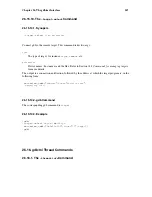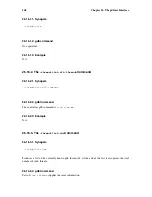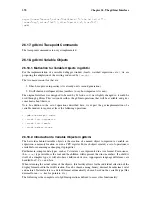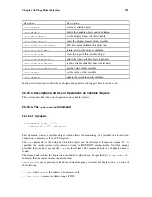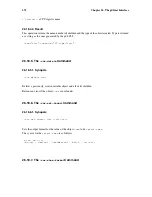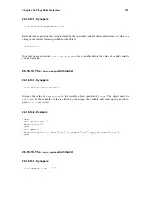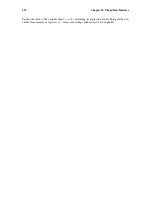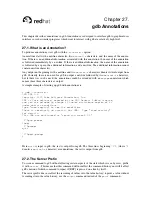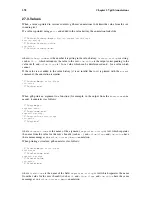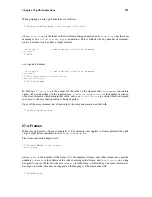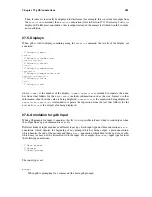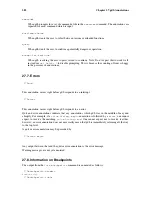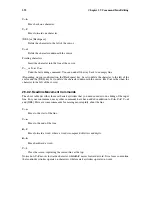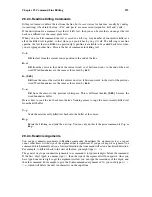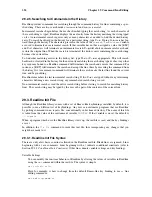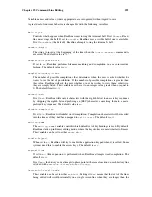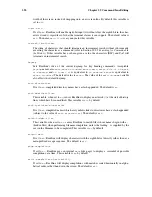
Chapter 27. gdb Annotations
281
Then, if source is to actually be displayed for this frame (for example, this is not true for output from
the
backtrace
command), then a
source
annotation (refer to Section 27.11
Displaying Source
) is
displayed. Unlike most annotations, this is output instead of the normal text which would be output,
not in addition.
27.5. Displays
When gdb is told to display something using the
display
command, the results of the display are
annotated:
^Z^Zdisplay-begin
number
^Z^Zdisplay-number-end
number-separator
^Z^Zdisplay-format
format
^Z^Zdisplay-expression
expression
^Z^Zdisplay-expression-end
expression-separator
^Z^Zdisplay-value
value
^Z^Zdisplay-end
where
number
is the number of the display,
number-separator
is intended to separate the num-
ber from what follows for the user,
format
includes information such as the size, format, or other
information about how the value is being displayed,
expression
is the expression being displayed,
expression-separator
is intended to separate the expression from the text that follows for the
user, and
value
is the actual value being displayed.
27.6. Annotation for gdb Input
When gdb prompts for input, it annotates this fact so it is possible to know when to send output, when
the output from a given command is over, etc.
Different kinds of input each have a different
input type
. Each input type has three annotations: a
pre-
annotation, which denotes the beginning of any prompt which is being output, a plain annotation,
which denotes the end of the prompt, and then a
post-
annotation which denotes the end of any echo
which may (or may not) be associated with the input. For example, the
prompt
input type features
the following annotations:
^Z^Zpre-prompt
^Z^Zprompt
^Z^Zpost-prompt
The input types are
prompt
When gdb is prompting for a command (the main gdb prompt).
Summary of Contents for ENTERPRISE LINUX 3 - SECURITY GUIDE
Page 1: ...Red Hat Enterprise Linux 3 Debugging with gdb ...
Page 12: ...2 Chapter 1 Debugging with gdb ...
Page 28: ...18 Chapter 4 Getting In and Out of gdb ...
Page 34: ...24 Chapter 5 gdb Commands ...
Page 44: ...34 Chapter 6 Running Programs Under gdb ...
Page 68: ...58 Chapter 8 Examining the Stack ...
Page 98: ...88 Chapter 10 Examining Data ...
Page 112: ...102 Chapter 12 Tracepoints ...
Page 118: ...108 Chapter 13 Debugging Programs That Use Overlays ...
Page 138: ...128 Chapter 14 Using gdb with Different Languages ...
Page 144: ...134 Chapter 15 Examining the Symbol Table ...
Page 170: ...160 Chapter 19 Debugging remote programs ...
Page 198: ...188 Chapter 21 Controlling gdb ...
Page 204: ...194 Chapter 22 Canned Sequences of Commands ...
Page 206: ...196 Chapter 23 Command Interpreters ...
Page 216: ...206 Chapter 25 Using gdb under gnu Emacs ...
Page 296: ...286 Chapter 27 gdb Annotations ...
Page 300: ...290 Chapter 28 Reporting Bugs in gdb ...
Page 322: ...312 Chapter 30 Using History Interactively ...
Page 362: ...352 Appendix D gdb Remote Serial Protocol ...
Page 380: ...370 Appendix F GNU GENERAL PUBLIC LICENSE ...
Page 386: ...376 Appendix G GNU Free Documentation License ...
Page 410: ......

